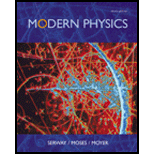
Concept explainers
(a)
Verify the equation for the magnitude of electric field.
(a)
Answer to Problem 1P
It is proved that the magnitude of electric field is given by
Explanation of Solution
Write the given equation for the relation between electric field and magnetic flux.
Here,
Write the equation for the magnetic flux.
Here,
Conclusion:
Substitute equation (II) in equation (I) and also substitute
Therefore, it is proved that the magnitude of electric field is given by
(b)
The change in speed of electron.
(b)
Answer to Problem 1P
The change in speed of the electron is
Explanation of Solution
Write the equation for the force acting on the electron.
Here,
Write the equation for the force acting on the electron in term of the acceleration of electron.
Here,
Substitute equation (III) in equation (IV) and compare it with equation (V).
Conclusion:
Integrate equation (VI) by giving appropriate limits.
Therefore, the change in speed is
(c)
The fractional change in frequency.
(c)
Answer to Problem 1P
The fractional change in frequency is
Explanation of Solution
Write the equation for the change in frequency of electron.
Here,
Substitute equation (VII) in equation (VIII).
Write the equation for the frequency of electron.
Here,
Conclusion:
Substitute
Substitute
Find the ratio
Therefore, the fractional change in frequency is
(d)
The explanation for lines at
(d)
Answer to Problem 1P
The
Explanation of Solution
The plane of electrons is parallel to
The
The
Conclusion:
Therefore, the
Want to see more full solutions like this?
Chapter 3 Solutions
Modern Physics
- Consider the circuit shown in the figure. The battery has emf ε = 69 volts and negligible internal resistance. The inductance is L = 0.4 H and the resistances are R 1 = 12 Ω and R 2 = 9.0 Ω. Initially the switch S is open and no currents flow. Then the switch is closed. After leaving the switch closed for a very long time, it is opened again. Just after it is opened, what is the current in R 1?arrow_forwardA capacitor with a capacitance of C = 5.95×10−5 F is charged by connecting it to a 12.5 −V battery. The capacitor is then disconnected from the battery and connected across an inductor with an inductance of L = 1.55 H . At the time 2.35×10−2 s after the connection to the inductor is made, what is the current in the inductor? At that time, how much electrical energy is stored in the inductor?arrow_forwardCan someone help me with this question. Thanks.arrow_forward
 University Physics Volume 3PhysicsISBN:9781938168185Author:William Moebs, Jeff SannyPublisher:OpenStax
University Physics Volume 3PhysicsISBN:9781938168185Author:William Moebs, Jeff SannyPublisher:OpenStax Principles of Physics: A Calculus-Based TextPhysicsISBN:9781133104261Author:Raymond A. Serway, John W. JewettPublisher:Cengage Learning
Principles of Physics: A Calculus-Based TextPhysicsISBN:9781133104261Author:Raymond A. Serway, John W. JewettPublisher:Cengage Learning Physics for Scientists and Engineers with Modern ...PhysicsISBN:9781337553292Author:Raymond A. Serway, John W. JewettPublisher:Cengage Learning
Physics for Scientists and Engineers with Modern ...PhysicsISBN:9781337553292Author:Raymond A. Serway, John W. JewettPublisher:Cengage Learning Modern PhysicsPhysicsISBN:9781111794378Author:Raymond A. Serway, Clement J. Moses, Curt A. MoyerPublisher:Cengage Learning
Modern PhysicsPhysicsISBN:9781111794378Author:Raymond A. Serway, Clement J. Moses, Curt A. MoyerPublisher:Cengage Learning Physics for Scientists and Engineers: Foundations...PhysicsISBN:9781133939146Author:Katz, Debora M.Publisher:Cengage Learning
Physics for Scientists and Engineers: Foundations...PhysicsISBN:9781133939146Author:Katz, Debora M.Publisher:Cengage Learning





